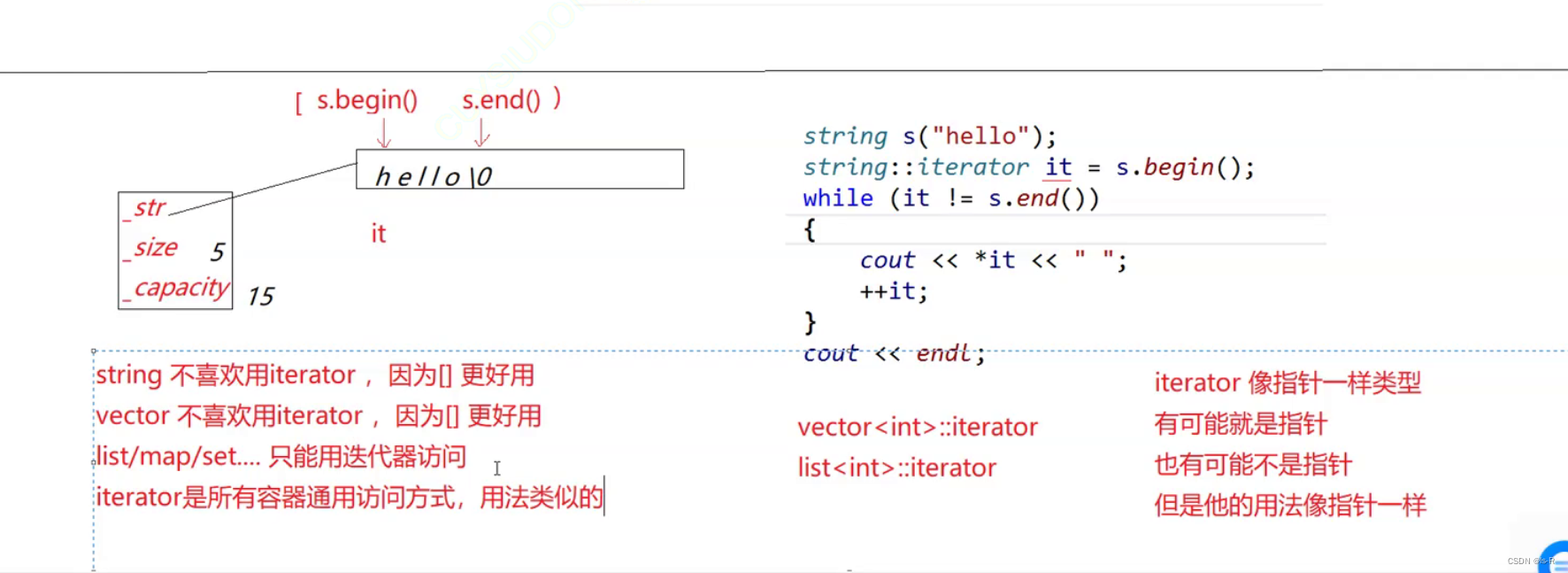string

std::string是一个字符串类模板,定义在头文件中。它是C++标准库中提供的用于操作字符串的模板类。
std::string模板类提供了一系列成员函数和操作符重载,用于对字符串进行各种操作,例如字符串的拼接、查找、替换、插入、删除等。
以下是一些常用的std::string成员函数和操作符重载:
length() 或 size():返回字符串的长度。
empty():检查字符串是否为空。
clear():清空字符串。
c_str():返回一个以null结尾的C风格字符串。
substr(pos, len):返回从位置pos开始的长度为len的子串。
find(str, pos):在字符串中从位置pos开始查找子串str,返回第一次出现的位置。
replace(pos, len, str):用字符串str替换从位置pos开始长度为len的子串。
insert(pos, str):在位置pos插入字符串str。
erase(pos, len):从位置pos开始删除长度为len的子串。
operator+:字符串拼接。
operator==、operator!=、operator<、operator>等:字符串的比较操作。
string类中的operator[]和string类中at的区别
在C++的std::string类中,operator[]和at()都可以用于访问字符串中的单个字符。它们的主要区别在于对于越界访问的处理方式。
-
operator[]:使用operator[]时,如果尝试访问越界的索引,行为是未定义的。这意味着编译器不会进行越界检查,如果访问了超出字符串长度的索引,可能会导致程序崩溃或产生不可预测的结果。因此,使用operator[]时需要自行确保索引的有效性。 -
at():与operator[]不同,at()函数会进行边界检查。如果尝试访问越界的索引,at()会抛出一个std::out_of_range异常。这使得在访问字符串中的字符时更安全,可以避免访问无效的索引。
#include <iostream>
#include <string>
int main() {
std::string str = "Hello, World!";
// 使用operator[]访问字符
char c1 = str[0];
std::cout << "Using operator[]: " << c1 << std::endl; // 输出:H
// 使用at()访问字符
try {
char c2 = str.at(0);
std::cout << "Using at(): " << c2 << std::endl; // 输出:H
} catch (const std::out_of_range& e) {
std::cout << "Exception caught: " << e.what() << std::endl;
}
// 尝试访问越界索引
try {
char c3 = str[100]; // 越界访问
std::cout << "Using operator[]: " << c3 << std::endl;
} catch (const std::out_of_range& e) {
std::cout << "Exception caught: " << e.what() << std::endl; // 输出:Exception caught: basic_string
}
try {
char c4 = str.at(100); // 越界访问
std::cout << "Using at(): " << c4 << std::endl;
} catch (const std::out_of_range& e) {
std::cout << "Exception caught: " << e.what() << std::endl; // 输出:Exception caught: basic_string
}
return 0;
}
在上述示例中,我们首先使用operator[]和at()访问字符串中的第一个字符,结果都是正常的。然后,我们尝试使用这两种方式访问越界的索引,结果显示了它们的不同行为。operator[]没有报错,而是产生了未定义的结果,而at()抛出了std::out_of_range异常,提供了更安全的访问方式。
迭代器
//一个类中四种迭代器
//iterator/const_iterator
//reverse_iterator/const_reverse_iterator

相比于其他容器,std::string类中的operator[]有以下几个优点,使其更适合于处理字符串:
-
简洁性:
std::string类中的operator[]使用起来更加简洁直观。通过使用索引值,可以直接访问字符串中的单个字符,而不需要使用迭代器或其他复杂的方法。 -
性能:
std::string类中的operator[]是通过指针算术实现的,因此在访问字符串中的字符时具有很高的性能。与使用迭代器进行遍历相比,使用operator[]可以更快地访问和修改特定位置的字符。 -
习惯性:
std::string类中的operator[]与C-style字符串的访问方式相似,即通过索引访问字符。这使得在处理字符串时,使用operator[]更符合程序员的习惯,更容易理解和维护。
然而,需要注意的是,operator[]没有边界检查,当使用越界的索引时,会导致未定义的行为。因此,在使用operator[]时,需要自行确保索引的有效性,以避免访问无效的索引。如果需要进行边界检查,可以使用std::string类的at()函数。另外,使用迭代器遍历字符串可以提供更多的灵活性,可以在字符串中进行逐个字符的处理,或者使用迭代器的其他功能,如逆向迭代等。因此,在处理字符串时,根据具体的需求和场景,选择使用operator[]或迭代器都是有优势的。
#include<iostream>
#include<string>
#include <list>
using namespace std;
void test_string1() //构造
{
string s1; //无参
string s2("hello word"); //有参
cout << s1 << endl;
cout << s2 << endl;
string s3(s2); //拷贝 深拷贝
cout << s3 << endl;
string s4(s2, 6, 5); //string (const string& str, size_t pos, size_t len = npos);
cout << s4 << endl; // size_t pos为拷贝开始位置 size_t len为长度 给缺省值可以 给的太长时直接拷到结尾
//npos为静态成员变量 =-1 所以size_t len不给值时,npos为42亿9千万,直接拷到结尾
string s5("hello word", 5);
cout << s5 << endl; //只用前五个
string s6(100, 'x'); //用100个x
cout << s6 << endl;
//cin >> s1 >> s2; //string重载了运算符<< >>
//cout << s1 << endl;
//cout << s2 << endl;
}
void test_string2() //赋值
{
string s1;
string s2="hello word"; //构造+拷贝构造 -》 优化为 直接构造
s1 = s2;
s1 = "xxxxx"; //
s1 = 'y';
}
void test_string3()
{
string s1("hello word");
cout << s1[0] << endl;
s1[0] = 'x'; //[]为重载运算符 返回的是引用(减少拷贝,修改返回对象)
cout << s1[0] << endl;
cout << s1 << endl; //s1也被改
//遍历每一个++
for (size_t i = 0; i < s1.size(); ++i) //s1.length() 也可以
{
s1[i]++;
}
cout << s1 << endl;
const string s2("word");
for (size_t i = 0; i < s2.size(); ++i)
{
//s2[i]++; //const对象会调用const 不能修改
cout << s2[i] << ' ';
}
cout << endl;
cout << s2 << endl;
}
//一个类中四种迭代器
//iterator/const_iterator
//reverse_iterator/const_reverse_iterator
void test_string4() //迭代器
{
string s("hello");
string::iterator it = s.begin();
while (it != s.end())
{
cout << *it << ' ';
++it;
}
cout << endl;
//范围for 自动迭代,自动判断结束 底层其实就是迭代器
//依次取s中的每个字符,赋值给ch
for (auto ch : s) //如要实现修改功能 可以加上引用 auto& ch
{
cout << ch << " ";
}
cout << endl;
list<int> lt(10, 1); //左闭右开 end为最后一个数据的下一个位置
list<int>::iterator lit = lt.begin();
while (lit != lt.end())
{
cout << *lit << " ";
++lit;
}
cout << endl;
for (auto e : lt)
{
cout << e << " ";
}
cout << endl;
}
void Print_string(const string& str) //const类型使用const迭代器 不能修改
{
string::const_iterator rit = str.begin();
while (rit != str.end())
{
cout << *rit << " ";
++rit;
}
cout << endl;
auto t = str.rbegin(); //string::const_reverse_iterator t = str.begin();
while (t != str.rend())
{
cout << *t << " ";
++t;
}
cout << endl;
}
void test_string5() //反向迭代器 rbegin rend
{
string s("hello");
string::reverse_iterator rit = s.rbegin();
while (rit != s.rend())
{
cout << *rit << " ";
++rit;
}
cout << endl;
Print_string(s);
}
void test_string6()
{
string s("hello");
s.push_back('-');
s.push_back('-');
s.append("word");
cout << s << endl;
string str("i am");
s += '@';
s += "!!!";
s += str;
cout << s << endl;
s.append(++str.begin(), --str.end()); //表示开始和结尾 此处即不要首尾
cout << s << endl;
string copy(++s.begin(), --s.end());
cout << copy << endl;
}
void test_string7()
{
string s;
string s1;
cout << s1.max_size() << endl;
cout << s.max_size() << endl; //42yi9qianwan 是写死的
cout << s.capacity() << endl; //15
cout << s1.capacity() << endl; //15 写死的
//扩容机制
string st;
st.reserve(1000); //保留+开空间 提前开好空间避免扩容
st.resize(1000); //开空间+初始化(在1000后插入) 不给值是0 st.resize(1000,‘x’); 给的x
size_t sz = st.capacity();
cout << "capacity changed:" << sz << '\n';
cout << "making s grow:\n";
for (int i = 0; i < 100; ++i)
{
st.push_back('c');
if (sz != st.capacity())
{
sz = st.capacity();
cout << "capacity changed:" << sz << '\n';
}
}
}
int main()
{
test_string1();
test_string2();
test_string3();
test_string4();
test_string5();
test_string6();
test_string7();
return 0;
}

string::insert
1、3、6

void test_string8()
{
string str("wo lai le"); //要求在空格处插入百分号
for(size_t i=0 ; i<str.size() ; )
{
if(str[i]==' ');
str.insert(i,"20%");
i+=4;
}else
{
++i;
}
cout<<str<<endl;
}
/*
for(size_t i=0 ; i<str.size() ; ++i)
{
if(str[i]==' ');
str.insert(i,"20%");
i+=3;
}
*/

string::erase

1: npos不给数值,默认删除到结尾
//先插入再删除
void test_string8()
{
string str("wo lai le"); //要求在空格处插入百分号
for(size_t i=0 ; i<str.size() ;++i )
{
if(str[i]==' ');
str.insert(i,"20%");
i+=3;
}
cout<<str<<endl;
for(size_t i=0 ; i<str.size() ;++i )
{
if(str[i]==' ');
str.erase(i,1);
}
cout<<str<<endl;
}
*/
//另一种方案 空间换时间
void test_string8()
{
string str("wo lai le"); //要求在空格处插入百分号
string newstr;
for(size_t i=0 ; i<str.size() ;++i )
{
if(str[i] != ' ');
{
newstr += str[i];
}else
{
newstr += "20%";
}
}
cout<<newstr<<endl;
*/
string::c_str

兼容c
void test_string9()
{
string filename("test.cpp");
cout<<fliename<<endl; // test.cpp
cout<<filename.c_str()<<endl; // test.cpp
/*
filename += '\0';
filename +="string.cpp";
cout<<fliename<<endl; // test.cpp string.cpp
cout<<filename.c_str()<<endl; // test.cpp 遇见\0结束
*/
FILE* fout = fopen(fliename.c_str() , "r");
assert(fout);
char ch = fgetc(fout);
while(ch != EOF)
{
cout<< ch;
ch = fgetc(fout);
}
}
string::find string::substr
//取后缀
void test_string10()
{
string filename("test.cpp");
size_t pos = filename.find('.'); //将.的位置赋值给pos
if(pos != string::nopos)
{
string suff = filename.substr(pos,filename.size()-pos); //从pos位置取filename.size()-pos长度的字符
cout<<suff<<endl;
}
}
void test_string11()
{
string filename("test.cpp.tar.zip");
size_t pos = filename.rfind('.'); //将.的位置赋值给pos
if(pos != string::nopos)
{
string suff = filename.substr(pos); //从pos位置取filename.size()-pos长度的字符
cout<<suff<<endl;
}
}
找url
string url="http://baidu.com/fafffd//";
void DealUrl(const string& url)
{
size_t pos1 = url.find("://");
if(pos1 == string::npos)
{
cout<<"非法url"<<endl;
return;
}
string protocol = url.substr(0,pos1);
cout<<protocol<<endl;
size_t pos2 = url.find('/,pos1+3');
if(pos2 == string::npos)
{
cout<<"非法url"<<endl;
return;
}
string domin = url.substr(pos1+3,pos2-pos1-3);
cout<<domin<<endl;
string uri = url.substr(pos+1);
cout<<uri<<endl;
}






















 325
325











 被折叠的 条评论
为什么被折叠?
被折叠的 条评论
为什么被折叠?








